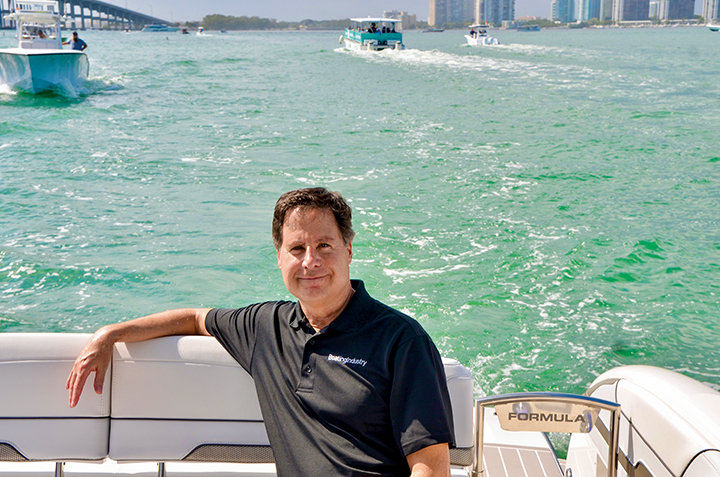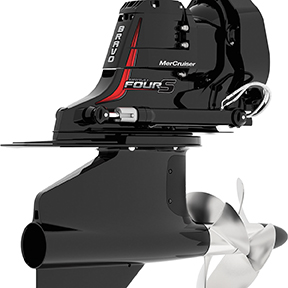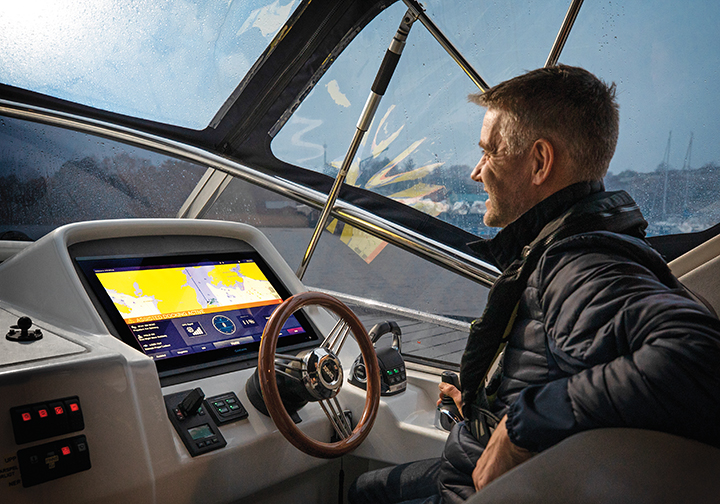The Sterndrive show goes on

By David Gee
With a history dating all the way back to 1930, when the first “inboard/outboard” was introduced by Johnson Motor Company, the sterndrive space has seen constant investment, improvement and innovation. And that continues today, especially since the pandemic drove a record rise in boat sales, and perhaps reinvigorated the sterndrive category.
“We’ve continued to see consistent demand for our gasoline sterndrives in the North American market in recent years but now as part of the sales surge we’re seeing across the industry, the demand for these solutions started to grow on par with other boat segments as well,” says Martin Bjuve, president of Volvo Penta Americas. “And it was understandably so. A large number of these sales were to first-time buyers, or buyers that have returned after years away from boating. The simplicity and versatility of sterndrives suits these new demographics well. The sustainability aspects – like impressive fuel economy and low levels of emissions – are also points of interest, especially among a younger generation of buyers who are often environmentally-minded.”
Talk to any sterndrive manufacturer and they will always tout low CO2 and exhaust emissions, but there are other advantages as well, including excellent low-speed maneuverability, beach and shallow water tilt, and an unobstructed swim platform.
“We are fond of saying nothing should get in the way of fun on the water, literally, and that includes motors at the back of the boat,” said Oliver Ray, senior manager business development at Ilmor, who was named this past summer to lead Ilmor’s new customer experience group. “When you have outboards hanging off the transom they might look great to an enthusiast who is really into that. But to a family simply trying to spend a nice day on the water swimming and climbing in and out of the boat you want a proper swim platform. That’s an area where sterndrives really have the advantage.”
Bravo!

Mercury Marine was thinking of families and others who like to surf, ride and do other tow sports when they unveiled the Bravo Four S forward‑facing drive with Smart Tow controls, a new drive system for MerCruiser engines. Digital controls that coordinate ballast, surf tabs and propulsion settings under a single and intuitive user interface make it easier than ever before to optimize water sports fun.
“The popularity of water tow sports — particularly, wakesurfing and wakeboarding — has surged. We carefully studied all the refinements that go into optimizing a boat’s wake for each of the various tow sports and devised a system to make those settings easy for the boater,” said Tim Reid, Mercury vice president of product development and engineering, in a press release.
The Bravo Four S forward‑facing drive can be found in MerCruiser 4.5‑liter V6, 6.2‑liter V8 and 8.2‑liter V8 sterndrive engines ranging from 250hp to 430hp.
Mercury says it built its first forward‑facing drive in 1949 when it invented the reversible gear case. The Bravo Four S drive builds on that foundation.
“We started with our highly visionary legacy designs and added new technologies, digital functionality for the user and seamless integration with the engine and boat controls,” Reid said. “This is the forward‑facing drive for the new generation of tow sports enthusiasts.”
Let me help you with that

Volvo Penta’s Aquamatic sterndrive also addresses the tow sports crowd with such features and smart options as speed control that automatically adjusts the throttle to maintain constant engine speed during load changes, like when a wakeboarder cuts hard, during turns or in shifting seas. The engine makes minute throttle adjustments so the driver can concentrate fully on having fun instead.
For many boat owners though, especially newer ones, the fun ends when you have to head back to the dock. Especially in windy or crowded conditions, and with a crowd on hand to witness your boat handling skills – or lack thereof.
To reduce the anxiety associated with that part of the boating experience, Volvo Penta recently announced the commercial availability of what they are calling “the industry’s first fully integrated Assisted Docking system.” The Volvo Penta system gives the captain better control when docking a boat by automating their intentions, compensating for variables such as wind and current, and helping the vessel stay on its intended course.
The main features of the boat docking system are moving in straight lines without manual compensation, standing still, slow maneuvering functionality, rotating around a fixed point, micro re-positioning and alignment, and side push for sideways docking.
“Our aim has long been to make things easier for our existing customers and to attract more people to enjoy the boating experience,” says Anders Thorin, product manager electronics at Volvo Penta. “Current Volvo Penta customers will be able to enjoy the Assisted Docking system with a relatively simple update, which can be performed by a local dealer. For those new to boating, it will be the first step into the world of modern boating and, we hope, the first of many new adventures to come.”
The Assisted Docking system will be available this spring for installation on new boat models, as an upgradeable option for Volvo Penta IPS-equipped motor yachts sized 35ft to 120ft long, and as a retrofit – which will require a software upgrade and new antenna – for existing Volvo Penta IPS-powered boats. The Assisted Docking system will be sold directly to Original Equipment Manufacturers.
“Building upon our Easy Boating philosophy, we remain dedicated to transforming the customer experience for today’s boater and the generations to come,” continued Volvo Penta’s Bjuve. “This is critical right now at a time where the industry will be working hard to keep these new boaters in the market. Not only does this tie back to our acceleration in sustainability, but also includes advancements in automation and connectivity. The Assisted Docking system is a concrete example of these efforts. It’s yet another industry first for us that takes away the stress and lets boaters just enjoy their time on the water.”
Customer experience

I enjoyed some time on the water in an Ilmor OneDrive-equipped Formula bowrider at the Miami International Boat Show a year ago (seems like a distant memory, huh?!). For someone who spends most of their boating hours in an inboard ski boat, this new standard for sterndrive propulsion in the recreational bowrider and cruiser markets is remarkable. It’s one thing to read about features such as “incredibly smooth shifting” in a promotional brochure, and quite another to experience it underway.
Powered by Ilmor 5.3L GDI-S, 6.0L MPI-S, 6.2L GDI-S, and 7.4L MPI-S engines, the One-Drive system is offered with electronic throttle and closed cooling systems as standard, including the uniquely closed-cooled exhaust manifolds.
“We know that exhaust manifold corrosion in sterndrives was a concern for many boaters, especially in saltwater environments, and we now offer a factory-backed Exhaust Manifold Extended Corrosion Warranty,” stated Ilmor’s Oliver Ray. “That gives boaters an unheard of seven-year/1000-hour level of protection against corrosion-related failures on their Ilmor One-Drive exhaust manifold. Simply put, if the manifold fails due to corrosion, Ilmor will cover the replacement part cost, shipping, and associated labor.”
So we’ve seen how far sterndrives have come in these past couple of decades particularly. Now, the last question. Will sterndrive markets continue to attract R&D dollars and innovation resources?
“Absolutely,” says Volvo Penta’s Martin Bjuve. “Diesel and gasoline sterndrives, together with the Volvo Penta IPS, are the core of our business and we remain fully committed to further developing these lineups. At the end of the day, we are and will remain a propulsion solutions company.”
“The sterndrive space is night and day different than what it used to be,” states Ilmor’s Oliver Ray. “There’s still a considerable market for sterndrives, and from our perspective anyway, we believe investment and innovation will continue.”




